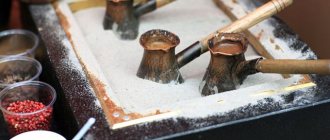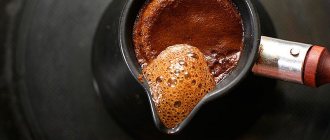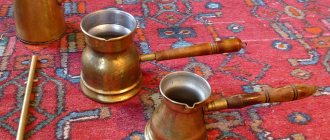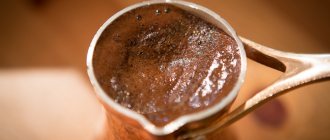How to choose Turkish coffee
The right variety
Classic recipes were created at a time when coffee conquered Africa, Asia and began its victorious march across Europe. There was no talk of any robusta back then: the drink was brewed only from Arabica beans. Nowadays there are sometimes tips to use robusta for making coffee. Everyone decides for themselves whether it is worth experimenting with this type of grain.
Pure Arabica is the best option for brewing in a Turk
There are three serious reasons not to make Turkish coffee from pure robusta or blends that contain it:
- Robusta is very bitter, and in the process of preparing coffee in Turk, the bitterness intensifies;
- Coffee brewed in a Turk is valuable not only for its taste, but also for its aroma. However, the smell of Robusta is not nearly as intense and rich as that of Arabica;
- Robusta has a higher caffeine content than Arabica. Robusta coffee made in Turk will be invigorating, but too strong, and will turn into a time bomb for the heart and blood vessels.
There are many Arabica varieties on sale with different aromas and tastes, so a coffee lover has nothing to lose by giving up Robusta.
How to prepare grains
Rules for choosing coffee beans for brewing in a Turk:
- The roasting of the beans should be no darker than medium (Viennese). A drink that is more deeply roasted turns out to be unbearably bitter and tastes and smells like an infusion of something burnt;
- The stronger the roast, the more bitterness and minimum sourness you feel in the finished drink. Brewing in a Turk further neutralizes the sour taste. Therefore, lovers of sourness should choose very light roasted beans;
- You shouldn’t chase elite varieties with a rich aftertaste. To brew Turkish coffee, it is enough to purchase high-quality Arabica coffee with a mild taste, for example, Kenyan coffee.
Grinding Turkish coffee
The advice to grind coffee yourself is not a quirk of the originals. Inside the coffee beans there are voids filled with essential oils. Grinding the coffee releases the aroma. The more time has passed since grinding, the weaker the smell.
It is recommended to store ground coffee from an open pack in a glass container with a sealed lid and use it within 2-3 weeks. When purchasing coffee in a specialty store, you need to take a small amount and not stock up for future use.
The best option for cezve is freshly ground grains. A lot of things have been broken regarding the degree of grinding. To make Turkish coffee, any grind is suitable, only the taste will be different. The finer the grind, the faster the extraction. A drink made from finely ground grains will be stronger than one made from coarsely ground grains.
Correct grinding
The best option is medium and fine grinding. Although ultra-fine grinding (to dust) is advertised as the most suitable for Turkish coffee, handling coffee powder ground “to dust” is difficult: it forms a suspension in the finished drink, and you have to wait for it to settle. It is recommended to use ultra-fine grind coffee only when all coffee brewing techniques have already been mastered and brought to perfection.
Types of electric stoves
To understand how to properly prepare coffee in a Turk on an electric stove, you need to understand what types of electric stoves there are.
When choosing an electric stove, the buyer is faced with a large assortment and often does not know how to make the right choice. The equipment is divided into the following types:
- by type of heating element;
- by installation method;
- according to the material from which the plate is made.
According to the installation method, the stoves are divided into built-in, portable, and separate versions, which come complete with the oven. Built-in models have a minimum of 3 burners, a maximum of 7 or more. Classic slabs are divided by width: standard and narrow.
An important area on electric stoves is the cooking surface on which the burners are located. Various materials are used to cover the hob:
- stainless steel;
- enamel;
- glass ceramics;
- strained glass.
Heating elements also come in different types:
- cast iron burners;
- halogen;
- induction;
- Hi-light.
Water for coffee
Chlorine is a taste killer, so untreated tap water is generally not suitable for making coffee. You can completely remove chlorine from water using a home carbon filter. The ozonizer also cleans water well from chlorine.
If there is no filter or ozonizer, then as a last resort it is allowed to brew coffee in a Turk using boiled and settled tap water. However, there are still too many impurities that impair the taste, so it is better to use bottled, spring or well water.
The chemical composition and acidity of the water are very important for the taste of the future drink. The fact is that coffee is rich in acids. If brewed in too alkaline water, the taste will lose its richness and fade. The ideal acidity of water for Turkish coffee is pH 7.0, but water with an acidity in the pH range of 6.5 – 7.5 is also suitable.
In water that is too soft, the extraction process is unstable; in water that is too hard, the flavors disappear. The permissible range of water mineralization (the total number of dissolved particles, this parameter is usually indicated on the bottle label) is 75–250 mg/l. The best water is considered to have a mineralization of 120–150 mg/l, a calcium content of 17–85 mg/l and sodium content of no more than 30 mg/l.
Useful article: how to choose a Turk.
Helpful coffee brewing tips
There is an opinion in society that a ceramic pot is the best for making coffee on gas. Technically this is not true. By putting the pot on gas, you warm up the bottom of the pan as much as possible, then the heat moves to the top. And if the flame is too strong, the ceramic or clay bottom may not withstand the sudden heat and burst. The same thing can happen when washing hot dishes.
Never use an aluminum Turk. When heated, this metal reacts with the contents, which in itself is not acceptable.
Better pay attention to a high-quality copper Turk. Copper has high thermal conductivity, so heating and heat distribution from the fire occurs evenly. In such conditions, coffee oils optimally impart aroma to heated water, saturating and creating a unique bouquet. And in a thick-walled copper pot, do not allow it to boil, or rather, do not kill the coffee at the brewing stage. Remember that the degree of enjoyment depends on such little things and do not skimp on the necessary.
Some of the best grain options include ]Egoist[/anchor], Jardine, Lavazza and Julius Meinl.
The method of preparing coffee over a fire is the best way to make the drink part of your morning ritual. Slowly pour the brewed drink into a cup and watch the earth bloom. This will make your first cup feel like zen! We believe that the best way to make coffee is the one that's right for you. But now, having mastered the intricacies of preparing a divine drink on a gas stove, enjoy the simplicity and taste.
Classic Turkish coffee recipe
Proportions
When brewing, the optimal proportion of Turkish coffee is 1:10 (1 part ground beans to 10 parts water), that is, 10 g of coffee will be needed per 100 g of water. However, here everyone decides for himself: some people like a stronger drink, others a weaker one. Other ingredients: sugar, milk, honey, spices, etc. are not used in the traditional version.
Step-by-step cooking technology
- Pour coffee into the cezve (add sugar and other bulk ingredients if desired), pour in half of the water at room temperature.
- Wait until the coffee stops releasing air bubbles (“blooming”).
- Add the rest of the water into the Turk, in which you have previously diluted the remaining liquid ingredients, for example, milk or honey (optional). The liquid level should not be higher than the narrowing of the neck, otherwise the foam will splash out when heated.
- Place the Turk on the stove burner, turning on the lowest heat. If you have time, you can hold the Turk in your hand over the fire.
- After a minute, stir the contents of the vessel so that there are no lumps left in the coffee. Subsequently, do not stir again.
- Attention! Under no circumstances should the coffee be allowed to boil. As soon as the foam in the Turk begins to rise (this happens at a temperature of 95–96 °C), the coffee along with the grounds should be poured into a preheated cup.
- It will take approximately 2-3 minutes for the extraction process to complete and the grounds to settle. After this, coffee is served to the table.
The Turkish coffee recipe given is basic. By experimenting with the initial temperature of the water in the Turk (from ice-cold to moderately warm), the degree of grinding and frying, you can achieve a signature, unique taste.
Cook properly until a stable foam appears.
Helpful Tips:
- In order for the aroma and taste of coffee to be revealed more fully, a little table salt (necessarily not iodized) is placed in the Turk along with ground coffee: literally on the tip of a knife. The taste of salt will not be felt in the finished coffee;
- To enhance the aroma of ground coffee, it is sometimes recommended to heat it in a Turk before adding water. This must be done extremely carefully so that the powder does not char. It is better not to roast ultra-fine ground coffee;
- if you want to brew coffee with sugar or spices, then all dry additives are mixed with ground coffee before it is poured with water. Liquid ingredients (for example, syrups or honey) are dissolved in water in advance;
- the coffee must not be allowed to boil or the foam to splash out: then the drink will lose both taste and aroma;
- Coffee brewed in a Turk must be served with a glass of water at room temperature: a sip of water will allow you to cleanse your receptors and more fully enjoy the taste of the drink.
Step-by-step cooking instructions
Measure out the required amount of cold water. Place the pot of water on the stove and increase the heat to medium-high (until the water is hot).
Add 1-2 heaped teaspoons or 1 tablespoon) coffee per demitasse cup (3 ounces). Don't interfere yet. Just let the coffee float to the surface. If you stir it now, lumps may form.
Add sugar to taste. Don't stir yet, let the water warm up a little. Once the coffee begins to submerge and the liquid is hot enough to dissolve the sugar, stir it a few times and then reduce the heat to low. You have to stir it several times.
When you see a bubble “ring” (when the coffee begins to “bloom”) forming on the surface, reduce the heat slightly or move the cezve away from the heat source. Notice the bubbles that form at this stage. The bubbles should be very small. From now on, watch your coffee carefully. Do not allow the drink to boil under any circumstances.
Many instructions for making Turkish coffee use the term "brew or brew", but this is completely incorrect.
The key idea is to let the coffee form a thick foam, and this happens at about 70°C (that is, much colder than the boiling point of water, which is 100°C. If the water boils, there will be no foam).
Keep it at the “foaming” stage for as long as possible without bringing it to a boil.
At this stage, you can even stir the drink slightly. The more foam, the tastier. Also, the coffee must be fresh, otherwise it will not foam. If the coffee starts to rise too much, remove it or simply reduce the heat.
Repeat this process until the foam “rises” and “cools” a couple of times at most (not 3-4 times as some instructions say. Even once is enough).
Then pour into cups (quickly at first to release the foam, then slowly), making sure there is an equal amount of foam in each cup. If you are serving multiple cups, you may want to add the foam to each cup with a spoon.
These are the basic rules for brewing coffee in a Turkish coffee pot. You can experiment with the initial heat of the water, the degree of roasting and grinding of the beans to achieve your ideal taste.
Useful lifehacks:
To fully reveal the aroma and taste of the drink in the cezve, you can put salt without iodine on the tip of the knife. The taste of salt is negligible to notice;
Some people recommend warming up the ground coffee in the cezve before adding water. This will enhance the aroma of the drink. However, the ground powder must not be allowed to char. It is not advisable to heat ultra-fine grinding;
If you want to make coffee with additives, you need to mix them dry with ground powder before pouring water. Liquid ingredients such as honey and syrup must be dissolved in water in advance;
Do not let the foam spill out, otherwise the drink will completely lose its aromatic and taste properties;
A drink made from cezve, in Turkey it is traditional to serve it along with a glass of water. Taking a sip of water before drinking will bring you full enjoyment of the taste of coffee, cleansing your receptors in advance.
Brewing coffee in a Turk is a kind of ritual, a fascinating process that is carried out by coffee lovers in an ancient vessel that is ideal for this. about which cezve to choose here . Despite the variety of stylish and “modern” devices, many people still prefer the Turk as a coffee maker today.
Arabic coffee
Recipe:
- Pour a teaspoon of sugar (to taste) into a preheated Turk.
- Over low heat, bring the sugar to a light brown color (before caramelization begins).
- Pour 100 ml of water over caramelized sugar and bring to a boil.
- Remove the cezve from the heat, add 10 g of ground coffee, stir.
- Pour in 1 tablespoon of cold water.
- Heat over low heat.
- As soon as the foam rises, remove the Turk from the heat.
- After 2-3 minutes, pour the coffee into heated cups.
You can add a pinch of cardamom or a pinch each of cardamom and cinnamon to the drink prepared according to this recipe. Specialized stores sell real Arabic coffee with cardamom.
Choosing a Turk for an electric stove
How to properly brew coffee in a Turk on an electric stove? First you need to choose a suitable vessel for preparing the drink:
- The cezve should have a thick bottom. In this case, the heat will be evenly distributed throughout the container, and there is less chance that the drink will burn.
- Baristas recommend using a classic-shaped Turk: wide bottom and narrowed top. Such a vessel will help preserve the aromatic and taste characteristics. A drink brewed in a classic Turk will turn out exquisite and amazingly tasty.
- Ceramic and porcelain are considered suitable materials. In the case of gas stoves, baristas are advised to choose copper cezves, but their use on electric stoves is not advisable.
Turk for glass ceramic hob
A delicious drink can be brewed on both a gas and electric stove. The material from which the burner is made matters.
It is better to use a ceramic or porcelain Turk on a glass-ceramic burner. A clay version is suitable, but it must be small in size so that the Turk does not exert excessive pressure on the glass ceramics.
It is not advisable to use Turks made of aluminum or copper for a glass-ceramic stove. Metal can damage the glass-ceramic coating.
On a note! In order to use a copper Turk on a glass-ceramic coating, you can purchase a special stand. It can be bought at an affordable price in stores that sell dishes and household items.
To avoid damaging the glass-ceramic coating, you should use a special adapter
Viennese coffee
Ingredients for one serving:
- 35 ml black coffee brewed in Turkish;
- 20 ml cream;
- 3–5 g dark chocolate;
- sugar - to taste.
Recipe: brew coffee in a Turkish coffee pot in the traditional way. While the grounds are settling in the cezve, whip the cream and sugar until stiff peaks form. Pour the coffee into a warm cup, pour the cream on top and sprinkle it with chocolate. Serve with a sugar bowl or sticker, but additional sugar is generally not needed.
How to brew a drink on a gas stove
There are few differences in the question “how to brew coffee in a Turk on a gas stove.” Choose a suitable cezve, variety, grain grinding, water. The cooking process differs only in the need to regulate the heat. On an open flame, the cookware heats up quickly and does not allow the aroma to release.
At the first stage, the cezve is placed on medium heat - 3 divisions out of 5. If possible, use a flame diffuser. After the first settling of the foam, the drink is returned to the heat, but at the minimum setting - 1 out of 5.
Coffee with honey
Recipe:
- Dissolve honey in warm water (to taste, 0.5–1.5 tsp per 100 ml of water).
- Pour ground coffee into a Turk, add water and honey, then prepare using the same method as Turkish coffee.
To improve the taste, add a pinch of cinnamon, cardamom, ginger or other spices to ground coffee. The drink turns out to be very filling (calorie content of 100 ml is about 300 kcal), gives strength and satisfies hunger, so Turkish coffee with honey is good before exams or sports training.
What else is added to coffee?
A rich drink does not need any addition. But if you prefer more interesting shades of aroma or a mild taste, you can add:
- milk. Cow will add natural sweetness, vegetable will add new notes;
- chopped nuts;
- ice cream combined with grated chocolate;
- fruits, berries – orange, lemon, cherry, pineapple, strawberry;
- caramel or syrups;
- mint;
- spices like nutmeg, cardamom, cloves, ginger, cinnamon.
Experiment until you find the perfect variety for your preferences.
Just try not to overdo it, and don’t overwhelm the flavor of the base recipe with additional ingredients.
How to brew coffee on an induction cooker
The difficulty in preparing a coffee drink on an induction hob lies in the pulsed heating. In order for the grains to fully reveal their flavor and aromatic properties, you will have to periodically raise the pot by 5-10 mm.
By following the following instructions step by step, coffee on an induction cooker will turn out as aromatic and rich as if it was prepared on sand:
- set the power to 75% and place the cezve on the panel;
- when foam forms, reduce power to 50%;
- simmer the drink for 2-3 minutes. This is exactly how much coffee beans need to reveal their abundance of flavor and aromatic richness.
To enhance the flavor, baristas recommend adding a pinch of salt before cooking.
Turks for induction cooker
Due to technical features, it is impossible to prepare coffee in a copper pot on an induction cooker. Clay, ceramics and aluminum also do not generate induced current.
A suitable cezve for an induction cooker is a stainless steel geyser coffee maker with a ferromagnetic thickened bottom. The Turkish gipfel fits these criteria. Its outline resembles an ordinary ladle, and the classic cone-shaped shape of a traditional vessel is only slightly indicated. Despite the fact that the Gipfel is an induction Turk, there is no “Induction” mark on it. It is important to clarify this formality before purchasing. Not the entire company's product range is intended for induction devices.
An induction Turk is a practical and undoubtedly useful thing. But what to do if you don’t want to part with your favorite jazz? An adapter stand made of ferromagnetic material will be a good solution to this problem. The induction disk is placed on the burner, and a vessel made of any material can be placed on it.
Varshavsky
There are two variations of the Warsaw style coffee preparation method. The peculiarity of the recipe is the addition of an additional natural ingredient - baked milk.
Let's look step by step at how to make Turkish coffee with baked milk and with milk, and compare their taste.
For the first recipe you will need:
- Heat the milk in the Turk, avoiding the formation of foam;
- add 2 tbsp. tablespoons of ground coffee beans, a whole spoon of regular sugar and 1/3 of vanilla;
- put on low heat and wait until foam forms;
- remove from the stove and repeat the process three times;
- Pour into a wide cup and decorate with chocolate chips.
The option of cooking with milk at the first stage involves the classic method of cooking with water in a ratio of 100 ml to 2 teaspoons. Strain the resulting liquid. At the second stage, you need to prepare baked milk: heat until it starts to boil. Mix hot milk and coffee drink in a warm cup.
How to brew coffee on a ceramic stove
- Heat the vessel filled with ingredients to 90. A foamy crust should form.
- Turn off the heat.
- As soon as the foam starts to rise, remove the Turk from the stove.
- Let the drink brew for a couple of minutes. Afterwards, repeat the action again.
Due to poor heat transfer, the coffee creation will gradually be enriched with the flavor and aromatic tones of the ground beans.
View this post on Instagram
Publication from











